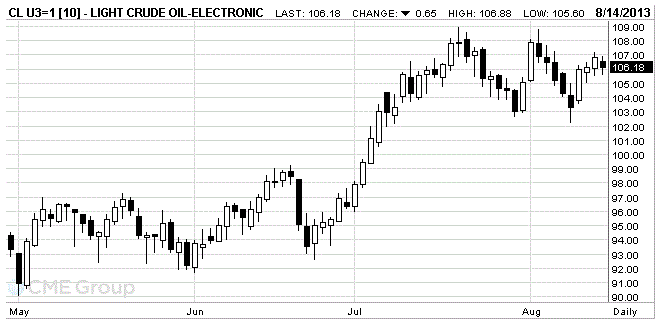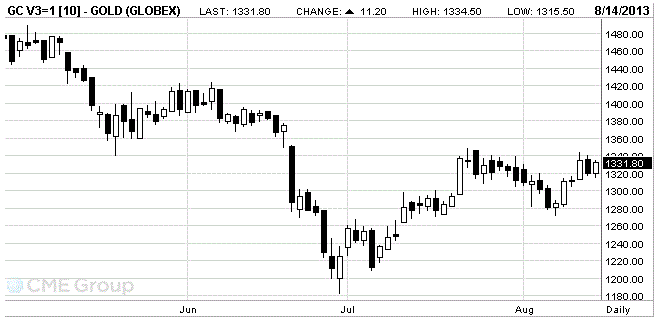Notícias do Mercado
-
16:41
Oil: an overview of the market situation
Oil prices fell today, dropping below $ 110 per barrel, due to investors' concerns regarding the fact that the U.S. Federal Reserve may soon cut back on the amount of its asset-purchase program. However, the tense situation in the Middle East, helping to hold down prices, not allowing them to fall even further. Note that the opposition in Egypt turned into a bloody phase: according to information circulating in the network, the demonstrators in clashes with the police and security forces have been killed or injured hundreds of people. The political problems in Egypt have become growth driver of the risk premium in the price of oil, and yet, after the "revolution" of the past year, there comes a relatively quiet period. However, the escalation of the crisis in Egypt could lead to the spread of problems in the neighboring territories. Against this background, the president of Egypt declared a state of emergency throughout the country.
Meanwhile, add the oil prices have ignored a report that the longest recession in the euro zone has finally ended. Preliminary data released by Eurostat, showed that the euro zone's economy emerged from recession in the second quarter of 2013. Gross domestic product grew by 0.3 percent quarter on-quarter in the second quarter, after a contraction of 0.3 percent in the first quarter. Economists had forecast a GDP growth of 0.2 percent. Quarterly GDP growth in the euro area was the fastest since the 1st quarter of 2011 compared to the same quarter of 2012, seasonally adjusted GDP declined by 0.7 percent. It was a little weaker than expected 0.8 percent drop. Eurozone recession persisted for six quarters. Earlier today, Germany and France reported on the stronger-than-expected growth in the second quarter.
We also note that the dynamics of the trade also influenced report on oil. According to the U.S. Department of Energy last week crude oil inventories decreased by 2.812 million barrels to 360.49 million barrels, gasoline inventories fell by 1.169 million barrels to 222.42 million barrels, distillate stocks rose by 2.027 million barrels to 128.482 million barrels. In addition, it was reported that refinery capacity utilization was 89.4% versus 90.9% a week earlier, and the oil terminal at Cushing fell 1.359 million barrels to 38.515 million barrels.
The cost of the September futures on U.S. light crude oil WTI (Light Sweet Crude Oil) fell to 106.18 dollars a barrel on the New York Mercantile Exchange.
September futures price for North Sea Brent crude oil mixture fell to $ 109.40 a barrel on the London exchange ICE Futures Europe.

-
16:21
Gold: an overview of the market situation
Gold prices rose sharply, while recovering most of the losses suffered yesterday. Note that the dynamics of trade affected by the publication of U.S. data and yesterday's statement by the head of the Atlanta Fed's Lockhart, who noted that the Federal Reserve may begin to reduce its purchases of bonds in September, despite the fact that inflation remains below the target of government. Furthermore, he added that the U.S. economic indicators are too mixed to ensure that the members of the Federal Reserve reduced the asset purchase program next month, and, ultimately, stopped her. It should be noted that the level of inflation in the U.S. remains well below the 2 percent target set by the Federal Reserve. But Lockhart said he saw no signs of proliferation of deflation. He noted that the current inflationary background is quite compatible with a slight decrease in the volume of purchases. Meanwhile, Lockhart said he saw significant progress in the labor market, but noted that weak economic growth has led to the formation of a pause.
Note also that the Department of Labor issued a report that showed that producer prices in the U.S. unexpectedly remained unchanged in July, as rising pharmaceutical costs offset the fall in energy prices.
The Labor Department said that its producer price index was flat in July after a 0.8% increase in June. Economists had expected the index to rise by 0.4%. Basic producer price index, which excludes food and energy, rose 0.1% in July after rising 0.2% the previous month. According to expectations, the underlying index should have grown by 0.2%.
We add that, according to traders, gold prices are likely to increase in India this week, due to the recent increase in import duty, which was introduced on Tuesday. The Indian government raised the import duty on gold for the third time this year in an attempt to strengthen the rupee and reduce the trade deficit of the country.
The cost of the October gold futures on COMEX today rose to $ 1331.80 per ounce.

-
06:23
Commodities. Daily history for Aug 12’2013:
Change % Change Last
GOLD 1,321.00 -13.70 -1.03%
OIL (WTI) 106.55 0.44 0.41%
-